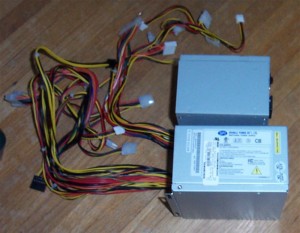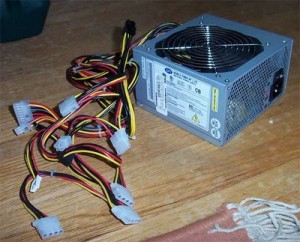Power Supply Review
Update: As much as this review is well over a decade old, this power supply outlasted many of the others I’d owned throughout the years. If it were still available at retail it would probably be a reasonably good buy!
After a few changes in our home network, namely the addition of a computer acting as a file/print server, I was in the market for a new power supply unit. The computer already had a power supply, but it was the typical no-name type included with a cheap case. I was looking for a quality PSU with a low price tag attached – not always an easy feat. After some searching, I came up with the Fortron ATX-400PN from NCIX.com. The regular price was a little over $40, and the sale price was $37.98 CDN.
Fortron Sparkle FSP/SPI – ATX-400PN
400W ATX 12V 20/24 PIN 120MM Fan
P4 AMD Ready OEM w/Noise Killer
P/N: ATX-400PN-B204
Death of an old power supply
Sometimes you just get lucky. The night before my Fortron ATX-400PN arrived, the old power supply crapped out. The old one was a 400Watt Powmax LP-8800D. It died with a “pop” while playing Warcraft 3, but not before emitting an unpleasant odor as it heated up. As it turns out, it wasn’t crazy about powering a Pentium 4 2.8Ghz processor, 3 hard drives, 2 cd-rom drives, and an nVidia Geforce2 440MX. I tried a few PSU calculators which gave different recommendations, everywhere from 240-325 Watts, still below the 400 Watt rating. The “pop” could have been circuit protection tripping, or could have been a component blowing. Either way, it was fortunate that the Fortron arrived the next day.
–
Initial impressions
The Fortron is heavy. It weighted 2x as much as the old power supply. More components, or heavy-duty components mean extra weight. Therefore, it’s often a sign of higher quality. Actually let me rephrase that… High quality name brand power supplies are usually heavy. The cheap freebie you get in a plain case purchase is usually quite light. The Fortron is also slightly larger.

Above: The old and new power supplies. As you can see, the new one (bottom) is larger in size. It is also twice the weight of the old one and has more cables.
Cables
The following sets of cables come from the supply:
- Motherboard Connector: 20-pin + 4-pin
- 12V ATX Motherboard Connector: 4-pin
- PCI-Express Connector: 6-pin
- SATA Connectors (2)
- Molex Connectors (3) (4-pin)
- Molex Connectors (2) (4-pin) + 1 Floppy Connector (4-pin)
Quite an impressive number of cables. You could feasibly have 7 drives connected plus a floppy. The motherboard connector is separated into two pieces, so it can easily be used in both older 20-pin motherboards as well as newer 24-pin boards. Cable lengths are between 28″ and 32″ for the drive cables. The motherboard and PCI-Express cables are about 20″ long. Multiply those numbers by 2.5 if you want the length in cm.
Power Supply Fan
The power supply fan is 120mm. Keep in mind that most are about 80mm. A larger fan means that it can move more air while rotating at a slower speed. This results in it being a much quieter fan. The way the fan is designed, it pulls air from just above the CPU which can help to keep those temperatures down. The back of the power supply is a honey-comb style structure, covered almost entirely with many holes, allowing air to flow through with minimal restriction.
Comparison
The following table compares the old power supply with the new one.
| Fortron ATX-400PN | Powmax LP-8800D | |
| Max Rated Output | 400 Watts | 400 Watts |
| +3.3V | 30A | 28A |
| +5V | 28A | 30A |
| +12V | 18A (+12V1) | 25A |
| 18A (+12V2) | ||
| Efficiency | >70% | ??? |
| Fan Size | 120mm | 80mm |
| Weight | ~4 pounds | ~2 pounds |
| Connectors | 20/24 pin | 20 pin |
| 4 pin | 4 pin | |
| 6 pin PCI-Express | 6 pin auxiliary | |
| SATA x 2 | ||
| Molex x 5 | Molex x 4 | |
| Floppy x 1 | Floppy x 2 |
A couple notes about the comparison. The 12V line in the Fortron is divided into 2 separate rails: +12V1 18A (yellow), and +12V2 18A (yellow/black). The Fortron also has ratings for the maximum wattage across combined voltage rails: +3.3V & +5V 150W Max / +12V1 & +12V2 348W Max.
You might notice that there are 2 types of 6 pin connectors listed. Note that sometimes the PCI-Express connector is also called an auxiliary connector, but it is not the same. The Fortron’s 6 pin PCI-Express connector has 2 rows of 3 pins each and is a newer style of connector required to feed extra juice to PCI-Express cards. The 6 pin auxiliary connector on the Powmax is an older style with a flat plug (6 blade-style pins all in a row) which I have honestly never had a use for, although I’ve seen it on many old power supplies. I believe it supplies extra power to certain workstations, but I can guarantee you that 99% of home users will not have a use for it.
Keep in mind that the numbers listed are rated amounts. Unfortunately, the manufacturer is the one who rates their power supply, and some manufacturers have decided they can put on whatever numbers they please, even if their product does not come anywhere near being able to provide the required output. That’s why you might see a 600Watt power supply for $30 and a name-brand 300Watt power supply for $50. I guarantee you that the 300Watt power supply for $20 more is probably going to put out more power than the one that claims 600. You often get what you pay for, and that’s why in the case of PSUs, it’s often a good idea to go with a good brand name. Tom’s Hardware did an article called “Inadequate and Deceptive Product Labeling: Comparison of 21 Power Supplies” back in 2002 and it’s worth a read. They actually tested power supplies to see if they met their ratings.
Conclusion
The Forton seems to be a good power supply. It has ample power connectors, a quiet fan, high efficiency rating, and pretty good reviews across the web.
The old Powmax wasn’t particularly bad, and I’m sure it would have lasted quite a bit longer had it been powering the average computer with only 1 hard drive and an optical drive. I simply asked for more than it could deliver. To it’s credit, it shut down with a pop, and it did give warning first (there was an unpleasant burning smell for about an hour before it finally gave up). Other supplies have been known to go out without warning and with a bang, taking your components with it.
That said, for a computer with today’s power demands, the Fortron is definitely a good buy. I believe the Fortron to be a mid-high range contender, at a low price point. The ATX-400PN doesn’t provide frill features like LEDs, sheathed cabling, displays, or custom knobs and adjustors. What it does provide is a solid, efficient, cool and quiet power supply. This isn’t a power supply for modders, but it is a supply for the average person who wants a no-worry quality supply that’s going to meet their needs without breaking the bank.
